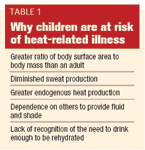Putting the chill on heat-related illness
Children are especially vulnerable to conditions ranging from mild heat cramps to life-threatening heatstroke. Early intervention and effective education are the keys to preventing disaster.
Heat-related illnesses-in particular, heatstroke that leads to death-gain national attention when public figures are the victims. Korey Springer, a lineman for the Minnesota Vikings, suffered fatal heatstroke in 2001, and Steve Belcher, a pitcher for the Baltimore Orioles, died during spring training in 2003 from heatstroke and the effects of a dietary supplement containing ephedra that he was taking to enhance his performance in the sport.
What does not gain as much attention on the national level are the young athletes, and other youths, who die every year from heatstroke. Last year alone, three high school football players died as a direct result of heatstroke.1 Between 1979 and 1999, according to the most recent available national data, an average of 182 deaths per year were attributable to excessive heat exposure.2 Researchers at General Motors have identified at least 228 children who died between 1996 and 2003 in all regions of the country as a result of being left or trapped in a hot automobile; the number of such deaths increased by almost 70% between 2002 and 2003.3 And these statistics only enumerate fatalities. Data on the far greater number of victims of other types of heat illness and nonfatal heatstroke do not exist. Often, these victims are our patients, because children are especially at risk of heat-related illness.
Heat illness covers a spectrum of complaints, from relatively benign heat cramps to potentially fatal heatstroke. The two key points for pediatricians to keep in mind with regard to heat illness are the importance of early recognition and, especially, prevention. Death from heatstroke is entirely preventable.

Certain children are particularly susceptible to heat illness and require special vigilance. They include children younger than 2 years, young athletes, and patients with certain underlying medical conditions such as cystic fibrosis, sickle cell disease, and diabetes insipidus.
How heat-related illness occurs Effective management of heat-related illness depends on a basic understanding of the pathophysiology behind the disease. The body gains heat by means of basal metabolism and from the surrounding environment.5,6 More important, the body loses heat by four mechanisms: conduction, convection, evaporation, and radiation. The last two are key.5,6 Heat-related illness occurs when these thermoregulatory mechanisms are impaired or the heat generated by either exertion or increased ambient temperature exceeds the amount of heat that can be lost.
This is especially true when ambient air temperature is greater than skin surface temperature, leaving evaporation as the only mechanism of heat loss available to the body (radiation typically accounts for up to 60% of heat loss when ambient temperature is lower than skin surface temperature). When humidity reaches 75%, the surrounding air is so saturated that sweat can no longer evaporate, and the body has no means of heat loss left. For this reason, you will see most patients with heat illness when both temperature and humidity are high. As mentioned, heat-related illness spans a continuum from heat cramps, the most benign form, through heat exhaustion to heatstroke, a potentially fatal condition.
2 Commerce Drive
Cranbury, NJ 08512
All rights reserved.